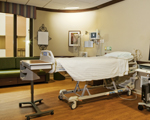January 2010 held a highly anticipated milestone for acoustical consultants. The definitive guide called 2010 FGI/ASHE Guidelines for Design and Construction of Health Care Facilities has a greatly expanded acoustics section in this year’s edition. How will you deal with the new noise, privacy, and acoustical requirements for healthcare facilities? Join us at SoundHealthcare 2010, a Health Care Acoustics Training Seminar, and find out what you must know about the new FGI Guidelines for HIPAA Compliance and LEED HC.
This is a brand new chapter in the 2010 FGI Guidelines, which went from a solitary partition transmission loss table in prior issues to an eighty page guideline that comprehensively covers exterior noise, acoustical finishes, background noise, sound isolation, vibration, sound masking systems, audio systems and alarms. As a result, acoustical consultants are hoping that architects and engineers will appreciate the breadth and importance of acoustics and consequently incorporate acoustical design early in a project when it is most cost effective.
Included in the guidelines are design criteria for background noise due to building mechanical systems for various types of spaces. Noise Criteria (NC) and Room Criteria (RC) are used as the guideline metric. Among the listed spaces are exam rooms, which are separately identified for the first time in a commonly used reference source.
At first glance, the NC/RC(N) recommendation of 30-40 for exam rooms may appear to be a little high, particularly when compared with the ASHRAE NC/RC(N) 25-35 range historically used for patient rooms (which has also been increased to NC/RC(N) 30-40 in the Guidelines). The main reason for this increase is to provide more background masking noise to increase oral patient privacy. While this may seemingly be detrimental for medical staff who need to hear for diagnoses, these sound levels are well below that which has been experimentally shown to diminish sound perception through a stethoscope (Zun and Downey, Academic Emergency Medicine, July 2005). All in all, hopefully it will prove to be a reasonable increase that allows more speech privacy without compromising diagnoses.
If you need help in interpreting and implementing these new Guidelines, an acoustical consulting firm like Acoustics By Design can assist and add patient-centered value to your project. We’ve already helped many healthcare clients with acoustical designs that exceed patient expectations. To learn more, join us at SoundHealthcare 2010, a Health Care Acoustics Training Seminar(Registration is now closed). There is no registration fee, but you must register in advance, as space is limited.
